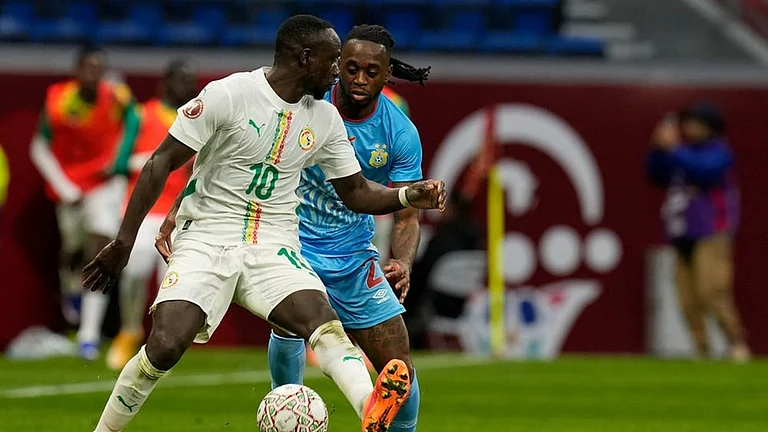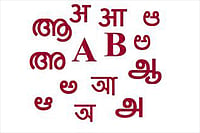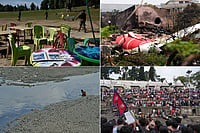An hour’s drive from the centre of Mexico City in the Valley of Mexico there are ruins of an ancient city now known as Teotihuacán, with a number of giant pyramids whose shapes echo the mountains in the background, and with the remains of apartment compounds, plazas, temples, murals and palaces. Teotihuacán is not its original name: it is a name given by the Náhuatl people, more recent settlers in that part of Mexico who never met the old ones who built it. So its original name has been lost, like the Toltec people who built it two and a half millennia ago and made it a centre of trade and the most important city in Mesoamerica. Walking along the Avenue of the Dead in deserted Teotihuacán is like being transported back to our own past, the mysterious city of Harappa, whose real name we also do not know. Mexico, like India, has a ‘past before the past’.
My visit to Mexico was a last-minute surprise. I needed to get to California, but there was a ban on travel from India to the US. The only way to get around that was to include a two-week stop in Mexico, after which I would no longer be ‘traveling from India’. And yet, as I breathed the air of Mexico, and my linguistic antlers picked up the trail, I was reminded all the time of India, of our similar pasts and a present that felt in so many ways…familiar.
Mexico is one of the ten most linguistically diverse countries in the world. There are officially sixty-two indigenous languages belonging to different families, distributed across the length and breadth of Mexico. Náhuatl and Maya, a language from the Yucatán peninsula on the Caribbean coast, are still widely spoken. Like in India, however, many of the smaller local languages are disappearing, as their speaker communities, especially the children, shift to Spanish.
For both Mexico and India, the encounter with Europe was a watershed. India saw the slow transformation of British traders into a force that defeated a Mughal Empire in decline, while in Mexico Spanish conquistadors arrived on the scene one fine day and put an end to the Aztec Empire. In both cases the infiltrators were men who came by ship, and initially in both Mexico and India both sets of men found local wives, passing on their genes along with their languages.

A section of the ruins of Harappa, a city coterminous to Teotihuacan
At this point the stories diverge. In Mexico Spanish men continued taking indigenous wives, creating a large population of ‘mestizo’ children, of mixed descent, while other people on the fringes continued to be fully indigenous. At the top of the food chain a White elite emerged, descendants of later male settlers from Spain who came with women. In colonial India this sort of hybridisation ended when Lord Cornwallis became governor general—right after the United States, with a White settler population, won its independence from Britain. Cornwallis was convinced that the real danger to British interests in the US had been the existence of a local White population estranged from the mother country. Soon, with the opening of the Suez Canal, large numbers of single British women began sailing to India looking for suitable British husbands, and anti-miscegenation laws came into force to stop British men from marrying Indian women. The number of Anglo-Indians did not rise much after this, and the English language spread only modestly, mainly among Indians who worked for the British, and only as a second language for work. Then, at the time of independence, the British and many of the Anglo-Indians went back to Britain. Indians were alone again.
The result is that the Spanish language penetrated Mexico as a first language much earlier than English did in India, though since independence we have been catching up, with more and more primary schools in English coming like Pied Pipers and wooing our children away. Both countries are now at the point where our own indigenous languages are in danger: Mexico is now seen as a Spanish-speaking country, while if things continue as they are going India is all set to become, by a few orders of magnitude, the largest English-speaking nation on Earth.
César, who drove us to see Teotihuacán, told us that when he was a child he would ask his grandmother why they never spoke in Zapotec, but only in Spanish. Zapotec is a tribal language spoken in southwestern Mexico, in the richly folkloric state of Oaxaca. (It was César who told me that the English word ‘tomato’ came from the Mexican word xitomatl, and reminded me that our green chillies in India had come from Mexico too). He said his grandmother would respond angrily when he asked her about Zapotec, and ask him if he thought she was just a wild woman who didn’t know Spanish. This was exactly how my grandmother, in Trinidad, would try to turn me away from the language we had brought from India, Bhojpuri, because she was afraid that I would sink back to being like the indentured labourers we had once been if I ventured too close to the old tongue. Both of us, Mexico and India, are letting go of timeless treasures as we chase after worldly success.

Grand Courtyard The author (left) before the grand pyramid at Teotihuacan
The similarities between Mexico and India are not just in the tides that pull at our languages. They even extend to our physical appearance. My son-in-law, who was my travelling companion while I was in Mexico, was constantly being mistaken for Mexican and spoken to in Spanish, while we would amuse ourselves trying to guess which of the people we saw walking by were Indians like us, making an age-old border crossing from Mexico to the US, and which were ‘Indians’ of the other type, Native Americans, who truly did look like us.
For someone like me who studies human migration, there is something reassuring in finding a story repeating itself like this, with small variations, in far-flung parts of the world. It makes the pattern all the more credible. One feature common to both our stories is the fact that the first migrants from Europe had been men, something geneticists are telling us is true of earlier migrations too: DNA studies on the bones of early Indians show that theirs was also a story of male migrants meeting and marrying local women, and going on to make hybrid children who continued their line and brought them a sense of belonging to their new home. It all started thousands of years ago, when men came from the mountains of Iran into the Indus Valley, married early Indian women and, over centuries, built the city we now call Harappa, and when the early Toltec found the Valley of Mexico and settled there to build, again over centuries, the city we now call Teotihuacán. But even though they both vanished without telling us their real names, something of these old giants must surely live on in us.
My last thought about our connection with Mexico, waiting in Puerto Vallarta to take the last flight on my journey across the border, was of my curiosity about the Mexicans I saw all around me, as I ate the tortillas we in India would call rotis, and asked for the hottest salsa they made from Habanero peppers, which tasted a bit like our Bhut Jolokias, trying to get a glimpse into their lives. So different from my reaction to the American tourists I saw, who mostly seemed to be looking away from the things that, in my eyes, made Mexico special.
Were we twins separated at birth, and left to grow up on opposite sides of the planet?
(This appeared in the print edition as "The Harappa of Mesoamerica")
(Views are personal)
Peggy Mohan is a writer and linguist based in Delhi, and most recently the author of Wanderers, Kings, Merchants: The Story of India Through Its Languages

























